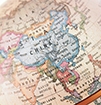Abstract
Over the past two decades, two events in Singapore and China, involving their citizens, drew attention to debates about state intervention in development processes as well as state–society relations, intra- and inter-ethnic social relations (between local and foreign residents) and transnational investment and labour flows generated through state-led race-based discourses. In 1992, Singapore’s government, after encouraging Chinese- owned enterprises in Southeast Asia to venture actively into China’s rapidly burgeoning economy, set the example by using its own state-owned enterprises (SOEs) to invest in the mainland. One core project, the Suzhou Industrial Park, involving co-investments by China’s SOEs was, by Singapore’s own admission, not successful because state leaders had failed to understand social relations involving local residents and foreigners even though both shared a similar ethnic identity. In 2011, in Singapore, a migrant family from China lodged a complaint against their Singaporean Indian neighbor for cooking curry, as it emanated a smell they could not tolerate. When a government agency mediating the dispute ruled that the Singaporean Indian family could only cook curry when the foreigners were not at home, this led to an uproar in ethnically Chinese- dominant Singapore, resulting in a nationwide ‘Cook and Share a Pot of Curry!’ movement because of the need to affirm a ‘Singaporean’ identity.
These two anecdotes should be set in the context of the core story of the last quarter of the 20th century: that of the rise of China and India on the world stage. Various kingdoms in the territory occupied by the current two states of India and China had flourished and attained global pre-eminence in such diverse areas as politics, social systems and science during their several millennia of history. In present times, it is in the arena of the economy that China and India have become increasingly renowned. The policies of these new political economic regimes in India and China have had far-reaching effects not only for these two countries in the past three decades but also for the global economy and other important players in the world, specifically the burgeoning economies of Southeast Asia.
A major lacuna to be filled is this: Southeast Asia in China and India, and China and India in Southeast Asia—the outcomes of this two-way flow of investments and peoples. However, we recognize that an assessment of this lacuna necessitates a study of China and India from a historical perspective. Both countries have been characterized as 'civilization' states. These are states within which entire civilizations were located and had given these countries and their peoples their identity and coherence. These identities have been transplanted to Southeast Asia, through trade in the pre-colonial period, to employment during colonial rule and as investments since the 1980s. These cross-border flows over history have led to new settlements in Southeast Asia from which new outlooks have emerged among locally born generations that have given rise to new forms of solidarity and identification. The advent of new generations of ethnic Chinese and Indians in Southeast Asia with no ties to China or India has spawned important debates about identity shifts which have not been registered by state leaders in Southeast Asia, China and India, at least as reflected in policy statements. For example, since the early 1990s the governments of China and India have actively called for investments from what they see as the Chinese and Indian 'diaspora' of Southeast Asia, presumably because of the ties of these ethnic groups to their ancestral 'motherlands'.



